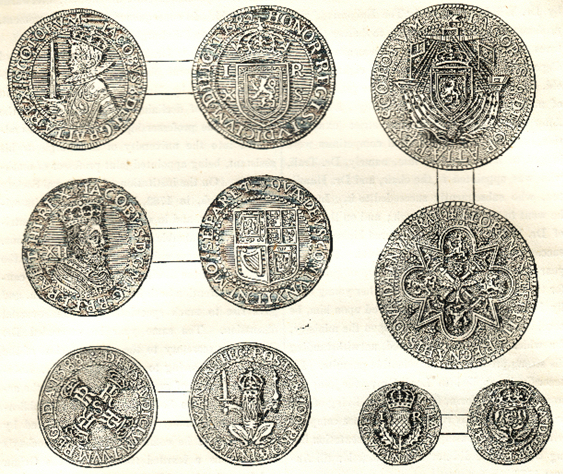|
PITTENWEEM, Baron,
a title (extinct) in the peerage of Scotland, conferred in 1606, on
Frederick Stewart, son of Colonel William Stewart, captain of the king’s
guard, who, on 31st July 1583, obtained a charter of the priory and
lands of Pittenweem, and was thenceforth styled commendator thereof.
This Colonel William Stewart, one of the unworthy favourites of James
VI., was the second son of Thomas Stewart of Galston, in Ayrshire, third
in descent from Alexander Stewart of Dreghorn, second son of Alan
Stewart of Darnley. On obtaining favour at court he seems to have
changed the spelling of his name to Stuart, as being of kin to his
majesty. Calderwood (vol. iv. p. 448) says of him: “colonel Stuart was
(as is constantlie reported) first a cloutter of old shoes. He went to
the Low Countries, where he served in the warres, first as a souldiour,
then as a captane, at last as a colonel. He returneth home, and was
imployed by the king to apprehend anie subject, in anie corner of the
kingdom, that the court had anie querrell at. He wanted not likewise his
rewaird, for he was gifted with the pryorie of Pittinweme, and married
the Ladie Pitfirrane, not without suspicioun of the murther of her
former husband.” In October 1582 he and Mr. James Halyburton, provost of
Dundee, were the king’s commissioners to the General Assembly. In
January 1583, after the Raid of Ruthven, by Colonel Stuart’s interest,
the king obtained permission from the confederated lords to visit the
earl of March at St. Andrews, and on his entrance into the castle there,
the colonel ordered the gates to be shut, and his followers excluded.
The profligate earl of Arran soon regained his former place in the royal
favour. In April, Colonel Stuart was sent ambassador to England. At a
parliament held at Edinburgh, 4th December of the same year (1583),
those who had been concerned in the Raid of Ruthven were declared guilty
of high treason. At this parliament it was also, says Calderwood, (vol.
iii. p. 761,) “statuted that the old placks, babees, three pennie peeces,
and twelve pennie peeces, sould be brought in betwixt and Julie next, to
be brokin; and that a new coine be stricken, foure pennie groats, eight
pennie groats, sixteen pennie groats, and that they be three pennie
fine. Yitt were they not so fine. This was done to get silver to
Colonell Stewart to pay the waiged men of warre. The burrowes dissented
from breaking of the old coin.” In Anderson’s Diplomata et Numismata
Scotiae are engravings of 13 gold and 23 silver coins of James VI., some
of which are here given:

[coins of James VI]
It was Col. Stewart, or
Stuart, as he called himself, who apprehended the earl of Gowrie at
Dundee, April 13, 1854. The earl was beheaded at Stirling on the 4th of
the following month, and on the earls of Mar and Angus and the master of
Glammis seizing the castle of that town, colonel Stuart hastened thither
with 500 men. Hearing of the approach of James with 20,000 men, they
fled to England, whence they returned in October 1585, with a large
force, and having laid siege to Stirling castle, succeeded in obtaining
possession of it and of the king’s person. On this occasion, Colonel
Stuart, who had been directed to defend the street at the west port of
the town, had a narrow escape. Being fiercely assaulted he fled to the
castle, but was followed, and overtaken by James Haldane, brother of the
laird of Gleneagles, who, as he was laying hands upon him, was shot by
the colonel’s servant, Joshua Henderson. This led to the downfall and
removal of the king’s favourites, and Colonel Stuart was deprived of the
command of the king’s guard. In June 1589 he was sent to Denmark, with a
full commission, to be present with the earl Marischal, James’
ambassador, at the ratification of the king’s marriage with the princess
Anne, the youngest daughter of the Danish king, and having soon after
returned to Scotland, he was again dispatched, on 28th March 1590, by
the nobility with five ships, to bring home the king and queen. On 20th
January 1592 he was warded in the castle of Edinburgh for taking part
with the queen in her intrigues against the chancellor, but was soon
released. On the 15th August following, having accused Lord Spynie of
secret conference with the turbulent earl of Bothwell, who at this time
was the torment of James’ life, Spynie challenged him to single combat,
on which he was again imprisoned for a short time in the castle of
Edinburgh, Spynie being warded in that of Stirling.
In 1606, the lands and
baronies belonging to the priory of Pittenweem were by act of parliament
erected into a temporal lordship, in favour of Colonel Stuart’s son,
Frederick, to him and his heirs and assigns, and he had farther charters
of the same in 1609 and 1618. Lord Pittenweem died without issue, and
the title has never been claimed by any heir general or assignee.
Previous to his death, he disponed the lordship to Thomas, earl of
Kellie, who, with consent of his son, Alexander, Lord Fenton,
surrendered the superiority of the same into the hands of the king.
|
